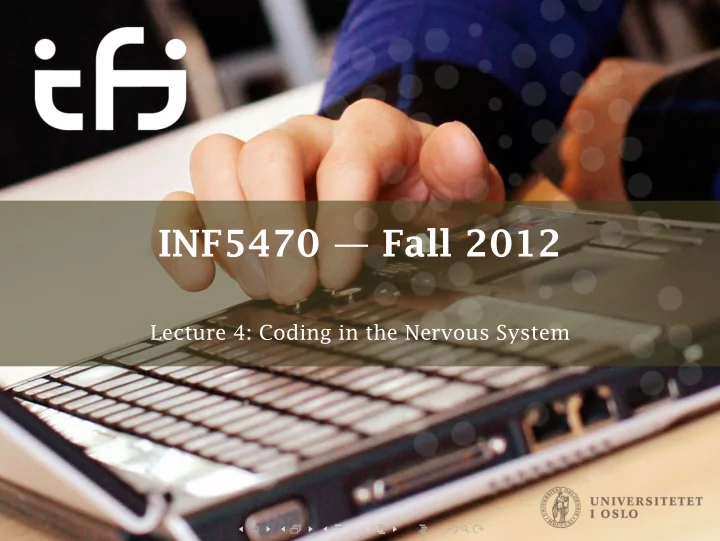

INF5470 — Fall 2012 Lecture 4: Coding in the Nervous System
Content Definition: Knowledege of a Code Experiments: Rate Codes Experiments: Temporal Codes Coding Categories Overview Weekly Questions Lecture 4: Coding in the Nervous System 2
Content Definition: Knowledege of a Code Experiments: Rate Codes Experiments: Temporal Codes Coding Categories Overview Weekly Questions Lecture 4: Coding in the Nervous System 3
Definition: Code A code is simply a function from one signal domain onto another. Lecture 4: Coding in the Nervous System 4
Definition: information on a Code (1/2) We do have knowledge about a code if we can assign unencoded and encoded signals to each-other for at least a subset of all possible signals. In other words if we can reconstruct some of the inputs to a system by observing internal encoded signals or vice versa, or if we can predict outputs from a system by observing an internal signal or vice versa. Lecture 4: Coding in the Nervous System 5
Definition: information on a Code (2/2) An even less stringent requirement: we do have knowledge of a code even if we can assign unencoded/encoded signals to members of limited set of encoded/unencoded signals with given probability . I.e. if we can reconstruct a partial input from looking at a output code, in other words limit the possible inputs. Or correspondingly, predict an approximate output from looking at an internal/input signal. Lecture 4: Coding in the Nervous System 6
Content Definition: Knowledege of a Code Experiments: Rate Codes Experiments: Temporal Codes Coding Categories Overview Weekly Questions Lecture 4: Coding in the Nervous System 7
Muscle Output Static Charges make Frog Legs Twich (Galvani 1780) Lecture 4: Coding in the Nervous System 8
Rate Response of Orientation Selective Cells in V1 (Hubel and Wiesel) Lecture 4: Coding in the Nervous System 9
Segmentation by Synchrony Lecture 4: Coding in the Nervous System 10
Content Definition: Knowledege of a Code Experiments: Rate Codes Experiments: Temporal Codes Coding Categories Overview Weekly Questions Lecture 4: Coding in the Nervous System 11
Precise Spike Patterns as Response to High Entropy Stimuli (Bair and Koch) Lecture 4: Coding in the Nervous System 12
Synfire Chains (Abeles) Lecture 4: Coding in the Nervous System 13
Phase Shift in Hippocampal Place Cells (O’Keefe and Recce) Lecture 4: Coding in the Nervous System 14
Spike Timing Dependent Plasticity, Spike Based Learning Lecture 4: Coding in the Nervous System 15
Reaction Time In Psychophysical Recognition Tasks (Simon Thorpe) (1/2) 150ms to 200ms reaction time in visual recognition task Lecture 4: Coding in the Nervous System 16
Reaction Time In Psychophysical Recognition Tasks (Simon Thorpe) (2/2) Lecture 4: Coding in the Nervous System 17
Content Definition: Knowledege of a Code Experiments: Rate Codes Experiments: Temporal Codes Coding Categories Overview Weekly Questions Lecture 4: Coding in the Nervous System 18
Coding Categories Overview Lecture 4: Coding in the Nervous System 19
Example Coding-Function: Latency Encoding Lecture 4: Coding in the Nervous System 20
Weekly Questions 1. How is a reconstruction from a rank order code of a black and white image impaired? Imagine 2x2 pixels, two of them black, the other two white. What information is lost in the encoding? 2. Can you again explain why a rate-, population code can also lead to overall fast response times and might be an alternative explanation of the Thorpe reaction times experiment? Lecture 4: Coding in the Nervous System 21
Recommend
More recommend